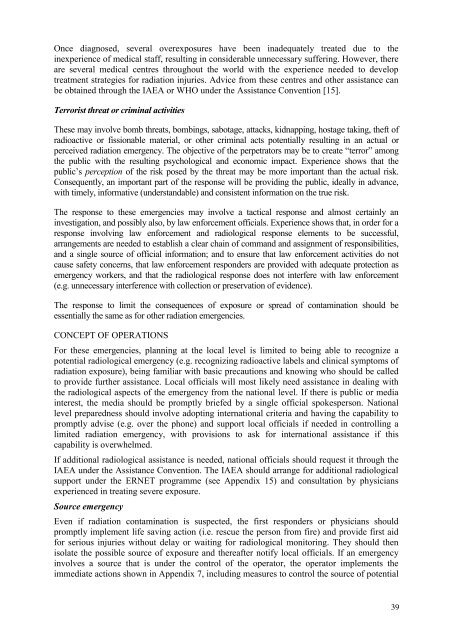epr-method (2003) - IAEA Publications - International Atomic Energy ...
epr-method (2003) - IAEA Publications - International Atomic Energy ...
epr-method (2003) - IAEA Publications - International Atomic Energy ...
You also want an ePaper? Increase the reach of your titles
YUMPU automatically turns print PDFs into web optimized ePapers that Google loves.
Once diagnosed, several overexposures have been inadequately treated due to the<br />
inexperience of medical staff, resulting in considerable unnecessary suffering. However, there<br />
are several medical centres throughout the world with the experience needed to develop<br />
treatment strategies for radiation injuries. Advice from these centres and other assistance can<br />
be obtained through the <strong>IAEA</strong> or WHO under the Assistance Convention [15].<br />
Terrorist threat or criminal activities<br />
These may involve bomb threats, bombings, sabotage, attacks, kidnapping, hostage taking, theft of<br />
radioactive or fissionable material, or other criminal acts potentially resulting in an actual or<br />
perceived radiation emergency. The objective of the perpetrators may be to create “terror” among<br />
the public with the resulting psychological and economic impact. Experience shows that the<br />
public’s perception of the risk posed by the threat may be more important than the actual risk.<br />
Consequently, an important part of the response will be providing the public, ideally in advance,<br />
with timely, informative (understandable) and consistent information on the true risk.<br />
The response to these emergencies may involve a tactical response and almost certainly an<br />
investigation, and possibly also, by law enforcement officials. Experience shows that, in order for a<br />
response involving law enforcement and radiological response elements to be successful,<br />
arrangements are needed to establish a clear chain of command and assignment of responsibilities,<br />
and a single source of official information; and to ensure that law enforcement activities do not<br />
cause safety concerns, that law enforcement responders are provided with adequate protection as<br />
emergency workers, and that the radiological response does not interfere with law enforcement<br />
(e.g. unnecessary interference with collection or preservation of evidence).<br />
The response to limit the consequences of exposure or spread of contamination should be<br />
essentially the same as for other radiation emergencies.<br />
CONCEPT OF OPERATIONS<br />
For these emergencies, planning at the local level is limited to being able to recognize a<br />
potential radiological emergency (e.g. recognizing radioactive labels and clinical symptoms of<br />
radiation exposure), being familiar with basic precautions and knowing who should be called<br />
to provide further assistance. Local officials will most likely need assistance in dealing with<br />
the radiological aspects of the emergency from the national level. If there is public or media<br />
interest, the media should be promptly briefed by a single official spokesperson. National<br />
level preparedness should involve adopting international criteria and having the capability to<br />
promptly advise (e.g. over the phone) and support local officials if needed in controlling a<br />
limited radiation emergency, with provisions to ask for international assistance if this<br />
capability is overwhelmed.<br />
If additional radiological assistance is needed, national officials should request it through the<br />
<strong>IAEA</strong> under the Assistance Convention. The <strong>IAEA</strong> should arrange for additional radiological<br />
support under the ERNET programme (see Appendix 15) and consultation by physicians<br />
experienced in treating severe exposure.<br />
Source emergency<br />
Even if radiation contamination is suspected, the first responders or physicians should<br />
promptly implement life saving action (i.e. rescue the person from fire) and provide first aid<br />
for serious injuries without delay or waiting for radiological monitoring. They should then<br />
isolate the possible source of exposure and thereafter notify local officials. If an emergency<br />
involves a source that is under the control of the operator, the operator implements the<br />
immediate actions shown in Appendix 7, including measures to control the source of potential<br />
39

















